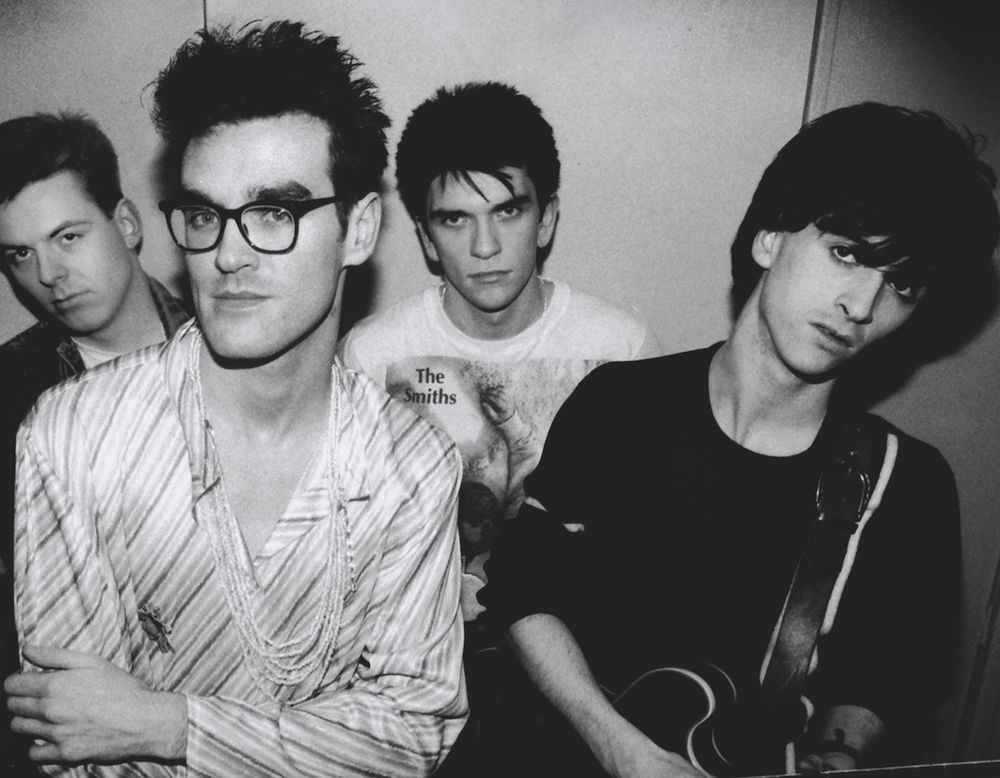Imogen Heap is a mystical force that has loomed over pop music for nearly two decades, delivering elaborate pop and fiery rock imbued with whimsy and enigmatic curiosity. The British innovator’s glittering presence has been apparent on the Top 40 even when her name isn’t the main credit.
Remember the inescapable Jason Derulo hit “Whatcha Say?” The chart-topping single sampled one of Heap’s most recognizable songs, “Hide And Seek.” More recently, “goodnight n go,” one of the standout tracks from Ariana Grande’s excellent Sweetener, was a fluttering remix/homage to Grande’s “all time favorite artist.” Dressing it up in trap beat triplets and magical whomping synths, Grande stayed true to a majority of the lyrics while riffing on the opening line and the ending a cappella melody. Both pop hits drew from Heap’s 2005 album Speak For Yourself.
Grande isn’t the only musician Heap has inspired: she has been sampled various times by A$AP Rocky, Mac Miller, and Lil B; Kelly Clarkson has covered her; she’s worked with MIKA, Jeff Beck, Jon Hopkins, Britney Spears, and even helped out on Taylor Swift’s 1989. She’s been featured for various well-known TV and movie moments. She soundtracked the final suspenseful and tender moments of Zach Braff’s cult hit Garden State and the uber-dramatic scene from The OC’s second season finale, which was wonderfully parodied by SNL a couple years later and more recently evolved into the new Rickroll. She even landed on the Shrek soundtrack. Whether you’ve been aware of it or not, Imogen Heap has permeated pop culture time and time again.
Heap began performing as a toddler and writing songs when she was 13, but her professional music career began at 18 years old, signing to Alamo records for her debut album I Megaphone — an anagram of her name. A slight detour from what she’s famous for now and her classical knowledge of piano, cello, and clarinet, I Megaphone was a rock-tinged album seething in angst and fury.
Next, due to her label’s money issues and management changes, Heap was given an ultimatum to deliver her sophomore album only to be told what she turned in was not promising. Alas, the universe was smiling upon Heap. After Alamo dropped her, she created the critically revered album Details with her friend Guy Sigsworth. It was their only album as Frou Frou but became a favorite among music supervisors, landing multiple placements in TV shows and movies.
After Frou Frou disbanded, Heap returned to her solo career. She was in debt, but believed in herself enough to mortgage her London flat. Frustrated with being dubbed only as the singer from Frou Frou, she locked herself in the studio, writing, producing, and performing the entirety of her sophomore full-length Speak For Yourself. In various interviews she detailed the misogyny and patriarchal structures she encountered. “There were times when I thought it would be good to have somebody in the studio to help put things together, but I knew if I invited anyone in just for a day, people would immediately be asking, 'So how did you find this amazing guy?' So I couldn't have anyone.” As a result, Speak For Yourself solidified her as an electronic pop mastermind.
Her music’s spellbinding composition is only a small portion of the incredible power she yields. Heap is also an innovator in technology. From pianos and accordions to circuit-bent Speak & Spells and giant cardboard tubes, she’s a hungry collector of resonators in any shape or form. She’s also invested in her own music technology, crafting gloves that stimulate and create sounds based on physical movement. Her Mi.Mu gloves have formulated a new way of understanding music composition in relation to performance: They can be one in the same. And if that isn’t impressive enough, she also is deeply passionate about the industry’s data and giving credit where it’s due: Mycelia Creative Passport is her “blockchain-driven musical data aggregator.” It’s no surprise that Heap has been tapped to compose the original score for JK Rowling’s adaptation of Harry Potter And The Cursed Child on Broadway, which was released as an official soundtrack album last Friday.
Taking my headphones out after indulging in Heap’s catalogue, I forgot how still the world is — for a moment, Heap’s music builds a cataclysmic and colorful barrier of sound, walling and escorting her listeners through the chaos of her creations. Albeit a small sample of what she has to offer, these 10 songs best encapsulate Imogen Heap’s meandering curiosity and innovation.
10. "You Know Where To Find Me" (from Sparks, 2014)
Bodies of water are sources of healing, escapes from what seems to be a fully discovered world on land. A place of contemplation, a means of travel, and even a source of danger, they can be just as fatally deceptive as they are welcoming. These are all the interpretations Heap took into account when personifying the Thames river on her turbulent single from her most recent solo album.
Although it was not her most successful, 2014’s Sparks was by far Heap's most ambitious. The concept album asked for fans to send in various found snippets of sound, as well as images of their footprints that would compose the album’s cover. She received almost 900 sound seeds that would grow into her fourth full-length.“You Know Where To Find Me,” the sixth single from the album, came to life when Heap decided she wanted to write a song one a boat in one day.
It captures the river’s various unforeseeable moods. “Be still with me,” the water beckons over and over again. Heap’s tone changes from sentimental (“To get something off your chest/ Cause we go a long way back”) to threatening (“Don’t mistake my open arms for what they are/ They can turn on you”). Its melody soars up and down between keys like a sparrow dodging between branches in a thick forest. Beginning with a stripped down piano that eventually crescendos into clamorous drums and hysterically overlapped vocals, it’s a moving single that reinstates nature’s nurturing and harmful faces.
9. “Just For Now” (from Speak For Yourself, 2005)
“It’s that time of year” only means one thing, and it’s not always as romantic as the gingerbread houses and mistletoe promise. There are countless Christmas songs for the memorial of pure bliss and blankets of white snow, but very few detail the emotional chaos that befall many of us during the holiday season. It’s a time for family affairs and abundance, but also one that thrives off of stress — stress to make things perfect and stress to keep the peace.
Originally written for one of the “Chrismukkah” episodes of The OC, “Just For Now” is a spiraling ride into familial discord. It proved to be too realistic and consequently too dark for the TV show, but it’s one of Heap’s most visceral and relatable songs, one that hits hard at any time of year.
8. “Wait It Out” (from Ellipse, 2009)
Heap is skilled at articulating both the intoxication of love and its romantic tribulations. “Wait It Out” is about the latter, questioning the age-old notion that time heals all. After a breakup, there are always so many questions and concerns: How can I possibly go on? What if I never fall in love again? What am I to do with all this wretched hollowness?
These are thoughts that stampede through Heap’s mind. Her lyrics are seeded with deep tragedy of lost love, but more presently the heartache that takes shape post-relationship. “Clamoring for the scraps/ In the shatter of us collapsed/ That cuts me with every could-have-been” -- oof, that’s a line. Moreover, such a personal tragedy is more universal than initially thought. It becomes a “stumbling cliched case.”
“Wait It Out” captures the panic of loss. “Are we just going to wait it out?” she wonders during the chorus. When tragedy strikes, emotions and adrenaline flood the veins with a hunger for action. But, with this impulse there is still no guarantee of resolution. Eventually we settle into the notion that it gets easier day after day. She repeats the title like a mantra towards the song’s end. Her voice fades into a more certain ease. Finally, time has caught up with her and she’s closer to healing.
7. “Getting Scared” (from I Megaphone, 1998)
Heap’s debut album seems to be the most angst-ridden and anger-filled of her releases. After its release, she was constantly compared to popular female rock singer peers like Tori Amos and Alanis Morissette. Though it may be hard to believe in this patriarchal day and age (ha!), Heap wasn’t inspired at the time by these empowered predecessors of the same gender. “When Tori [Amos] first came out, they would say she sounded like Kate Bush,” Heap explained at the time. “Now they think she sounds like Tori. Plus, when I wrote this album, I'd never even heard of these people.” The majority of Heap’s future work would venture into territory absent of guitar distortion, but looking back these earlier tracks are a refreshing and even surprising compared to her later projects.
The album’s star pupil “Getting Scared” -- which also appeared on the I Know What You Did Last Summer soundtrack -- is a real-life revenge fantasy, and it feels like one. Heap’s voice takes on a barbed-wire snarl during the chorus as she sings, “Who’s getting scared now/ Tell me, tell me how does it feel?” It’s easy to imagine her crawling out of the darkness with an owl-like stare, cornering her betrayer. “It feels so good where I’m standing.” Her power is intoxicating and invigorating as she towers over someone who saw her as a “little childhood playground toy.” Aside from its anger-charged tone, “Getting Scared” is a song of redemption, targeted towards a past roommate who betrayed Heap’s trust.
6. “First Train Home” (from Ellipse, 2009)
Sometimes being at a party can feel suffocating. An overcrowded room of people half-interested in small talk, their drunk bodies flinging against one another as they pass from conversation to conversation like dominoes: This is the precise feeling Heap paints on a standout from her third full-length Ellipse.
The song’s immediacy and upbeat melody are deceiving, possibly indicating the exciting anticipation of heading home on, well, the first train. But here, Heap uses the song’s twinkling propulsion, gears ticking away in a clock, in order to manifest the anxiety of an impending Irish goodbye.
Parties are usually their own form of escape, whether through new introductions, dancing, or alcohol. “First Train Home” is an escape from the escape. “I want to run in fields, paint the kitchen, and love someone,” she urgently insists. “And I can't do any of that here, can I?” Heap makes unwanted gatherings seem silly; she tells FOMO to fuck off.
https://youtube.com/watch?v=nZTDTW1X3Cs
5. “Hear Me Out” (from Frou Frou’s Details, 2002)
In 1983 Brian Eno recorded music intended for the documentary film For All Mankind, initially titled Apollo. “An Ending (Ascent)” closes the ambient and country music inspired soundtrack and is a glowing, sacred amalgamation of high-pitched synths. It’s an apt sound for venturing into an unknown frontier, ready to behold undiscovered wonder.
This quest for connection and vulnerable exposition is sampled on Frou Frou’s first and only album. On “Hear Me Out,” Heap aches for an ex-lover. She hopscotches from denial (“I refuse to believe that it's only me feeling/ Just hear me out: I'm not over you yet”) to reluctant acceptance that lends a feeling of starting over (“So how do I do normal?/ The smile I fake, the permanent wave of/ Cue cards and fix-it kits”).
At the song’s end, the tempo quickens and the vocals become breathier as if Heap has broken out in a sprint. She advocates for communication of any kind and the way her voice curls around the line “small talk will be just fine” is brilliant. There is no resolution to this unfortunate breakup, but the self-awareness of her unease is something relatable turned poetic: “I'm a slow motion accident/ Lost in coffee rings and fingerprints/ I don't wanna feel anything, but I do/ And it all comes back to you.” My heart breaks along with hers.
4. “Speeding Cars” (“Goodnight And Go” B-side, 2006)
An affecting B-side about mental health, “Speeding Cars” details the all-too-familiar grips of depression and the suicidal ideations that tag along with it. It’s hard to hear the words “don’t kill yourself” in a pop song, but the rare clarity of such phrasing makes this song that much impactful and necessary.
Heap articulates the commonality of depression, the heaviness of our mortality, and she radiates compassion. The track starts out with simple, blunt piano chords that snowflake into an arpeggiated melody. During the chorus, we’re swept up into something so intricate and yet vehement, a lullaby crossed with an antique music box. Heap’s words of support and whimsical melody wind the crank so we can hold our heads up a little higher.
3. “Let Go” (from Frou Frou’s Details, 2002)
Probably Frou Frou’s most popular song, “Let Go” is a cataclysmic escape, finding the splendor in upheaval. Its opening simmers with anticipation as eager violins and teetering synths usher us on an inconceivable adventure. It’s no surprise that this song was used to soundtrack the rekindling of a romance in Zach Braff’s Garden State. It’s a song that bubbles with wonder and excitement bordering on anxiety.
Change is coming. Liberation is near. Heap and Sigsworth are free floating in contemplative electro-pop and the next they’ve taken command of a synth-adorned spaceship, big beat drums writhing around them. Heap reaching for our hand, persuading us to turn against our fears and anxieties. “It’s alright, there’s beauty in the breakdown,” she confidently insists. Happiness and adventure are active pursuits; their threads must be pulled in order to unravel the seam of tedium. She urges us to find the magnificence in imperfection.
2. “Goodnight And Go” (from Speak For Yourself, 2005)
As cliche as it sounds, love is magical. It can be bewildering, astounding, warm, kind. All at once it is overwritten and underwritten. It can be painful and anxiety-provoking.
On one of Heap’s greatest achievements, new love is all of these things. The heart sinks and our mind runs over itself a million times just at the hint of a smile and the promise of something more. “Daydreaming, bed scenes in the corner cafe” -- Heap is getting a little heated! “And then I’m left in bits of recovering tectonic tremblings/ You get me every time.” Love is cruelly fun. But is this love or obsession? “Follow you home, you’ve got your headphones on.” Oh, dear. “And you think you’re alone.” Love makes us do some crazy stuff.
She imagines spending the night with her forlorn lover. He stays the night, but the heating goes out. “At my convenience,” she deviously whispers prompting him closer. Piano riffs overlapped with harp arrangements mimic the flight of butterflies. The song builds and bends at the mercy of love’s toying. One moment vocals wash over each other like a iridescent pipedream, the next a guitar solo by no other than Jeff Beck bursts through to illustrate the strain of possible rejection. Depending on the day, “Goodnight And Go,” could be anthem for love’s sweet reckoning or an obsessive nightmare narrative. That duality it what makes it a marvel.
1. “Hide And Seek” (from Speak For Yourself, 2005)
“Hide And Seek” is Imogen Heap’s most devastating and haunting track to date. Whether heard via a choice sync by a music supervisor or a chance encounter over a streaming service, the song lingers for days or even years.
Many speculate that “Hide And Seek” details the separation of Heap’s parents when she was 12. However, the songwriter has never come forward with its explicit meaning. Despite the mysterious circumstances, the song does paint a bleak image of a deserted home, where phantoms linger in imprinted outlines. “Oily marks appear on walls/ Where pleasure moments hung before.” One of the few modestly arranged songs from her catalog, “Hide And Seek” came together at a late-night studio session where her computer died. Left to other devices, Heap began recording her voice with a harmonizer, and a few minutes later the majority of the structure was there -- a good half-decade before Justin Vernon toyed with the same computerized a cappella sound up in the woods.
Her voice is haloed in reverb due to a harmonizer effect that makes her sound possessed with disquieting misery, bubbling to an overdose where she sounds occasionally alien. There’s a slight echo lending to the sense that Heap is treading through a dark, dingy cave either taking part in the titular game or hiding from her own personal demons.
“What the hell is going on.” Her syllables float away like flicks of ash from a bonfire. The track’s basic skeletal structure emphasizes Heap’s unique voice and evocative lyricism. She transforms a child’s game into a torturous struggle with denial. Unable to accept that her life is taking a different direction, she closes her eyes, spins around, and waits for the desertion to reveal itself to be a hoax.






